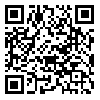1. Leyes Borrajo JL,Varelal G, Lopez C, Rodriguez-Nuñez I, Garcia FM, Gallas TM. Efficacy of chlorhexidine mouthrinses with and without alcohol: A clinical study. J periodontol 2002; 73(3): 317 – 321
2. Witt J, Bsoul S, Tao H, Gibb R, Dunavent J, Hamilton A. The effect of toothbrushing regimens on the plaque inhibitory properties of an experimental cetylpyridinium chloride mouthrinse. J periodontol 2006; 33 (10): 737 – 742.
3. Witt J,Ramji N, Gibb R, Dunavent J, Flood J, Barnes J. Antibacterial and antiplaque effects of a novel, alcohol – free oral rinse with cetylpyridinium chloride. The journal of contemporary dental practice 2005; 6 (1): 1-9.
4. Eslamipour F, Zabihi F. [Effect of instructing mothers on their performance in relation to the application of pit and fissure sealants in 6-8 year-old children in Isfahan]. Journal of Isfahan Dental School 2011; 7 (5): 804-9. [Persian]
5. Lafzi A, Abolfazli N, Sedaghat K, Momeni M. [ The evaluation of oral hygiene instruction in reduction of plaque index]. Journal of Dental School Shahid Beheshti University of Medical Sciences 2005; 23 (3): 475-83. [Persian]
6. Shirmohammadi A, Faramarzie M. [The Effect of the Oral Hygiene Instruction on Awareness, Attitude, and Practice of a Group of Patients]. Journal of Dentistry, Shiraz University of Medical Sciences 2010; 11 (2): 173-6.[Persian]
7. Enas Razzoqi Naaom. Effect of preventive periodontal health education on the oral hygiene of primary school children.mustansiria dental journal 2009; 6 (4): 402-407.
8. Lindhe J, Karrigt, Long P. Clinical Periodontology and implant dentistry, 3rd ed. Copenhagen; Munksgaard;1997, 350-5.
9. Shariatei B. [Assessment of CPITN]. Oral and Dental Health Management 2001. [Persian]
10. Ojima M, Hanioka T, Shizukuishi S: Survival analysis for degree of compliance with supportive periodontal therapy. J Clin Periodontal 2001; 28: 1091-1095
11. Novaes AB, Novaes Junior AB, Moraes N, Campos GM, Grisi MF: Compliance with supportive periodontal therapy. J Periodontol 1996; 67: 213-216.
12. Newman MG, Takei H, Klokkevold PR, Carranza FA. Carranza's clinical periodontology: Elsevier health sciences; 2011.
13. Newman MG, Takei H, Klokkevold PR, Carranza FA. Carranza's Clinical Periodontology: Expert Consult: Online: Elsevier Health Sciences; 2014.
14. Grazyna smiech- slomkowska. Joanna Jablonska-Zrobek.The effect of oral health education on dental plaque development and the level of caries-related Streptococcus mutans and Lactobacillus spp.European Journal of Orthodontics 2007; 29 (2): 157-160
15. Mc cracken G.I, Heasman L,Stacey F, Steen N, DeJager M, Heasman PA. A clinical comparison of an Oscillating rotating powered toothbrush and a manual toothbrush in patients with chronic periodontitis. J clin periodontol 2004; 31(9): 805 – 812.
16. Lazarescu D, et al. Efficacy of plaque removal and learning effect of a powered and a manual toothbrush. J Clin Periodontol 2003; 30: 726- 731
17. Wierzbicka M, Petersen PE, Szatko F, Dybizbanska E, Kalo I. Changing oral health status and oral health behaviour of schoolchildren in Poland. Community Dent Health 2002; 19: 243-250
18. Asadi A. [The Role of Standardized Patient in Medical Education and How to Prepared]. Research in Medical Education 2007;1(1):47-51[Persian]
19. Demetriou N, Tsami - Pandi A, Parashis A: Compliance with Supportive periodontal treatment in private periodontal practice. A 14-year retrospective study. J Periodontol 1995;66:145-149
20. Echeverria J, Sanz M. Mechanical Supragingival Plaque. In: Lindhe J, Karring T, Lang N. Clinical Periodontology and Implant Dentistry.4 th ed. Copenhagen: Blackwell Munksgaard; 2003.
21. O'Leary TJ, Drake RB, Naylor JE. The plaque record. J Periodontol 1972; 43: 38.
22. Carney PA, Dietrich AJ, Freeman Jr DH, Mott LA. A standardized-patient assessment of a continuing medical education program to improve physicians' cancer-control clinical skills. Academic Medicine 1995; 70 (1): 52-8.
23. Ebbert DW, Connors H. Standardized patient experiences: Evaluation of clinical performance and nurse practitioner student satisfaction. Nursing Education Perspectives 2004; 25 (1): 12-5.
24. A'Campo L, Wekking E, Spliethoff-Kamminga N, Le Cessie S, Roos R. The benefits of a standardized patient education program for patients with Parkinson's disease and their caregivers. Parkinsonism & related disorders 2010; 16 (2): 89- 95.
25. 25. Rickles NM, Tieu P, Myers L, Galal S, Chung V. The impact of a standardized patient program on student learning of communication skills. American journal of pharmaceutical education 2009;73 (1): 1- 10.
26. Tamblyn RM, Klass D, Schnabl G, Kopelow M. The accuracy of standardized patient presentation. Medical Education 1991; 25 (2): 100- 9.
27. Becker KL, Berg JB, Hyunjeong Park MPH R. The teaching effectiveness of standardized patients. Journal of Nursing Education 2006; 45 (4): 103.




